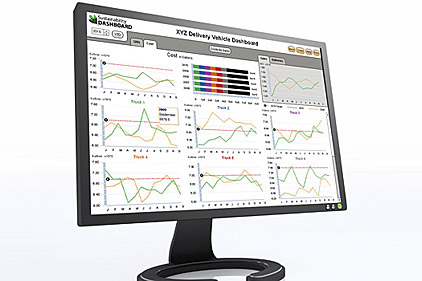Putting Dashboard Systems to Work

A July 2011 survey conducted by McKinsey and Co., a global management consulting firm, found that more and more companies—both large and small—are integrating sustainability principles into their daily business operations. Further, they are not doing so due to concerns about what the study calls “reputation management” (that is, how much positive PR might be generated by becoming more sustainable). Instead, they are becoming more sustainable because, quite simply, it is paying off for them. The researchers concluded that, “Saving energy, developing green products, and retaining and motivating employees all help companies capture value through growth and a return on capital and investment.”*
integrating sustainability principles into their daily business operations. Further, they are not doing so due to concerns about what the study calls “reputation management” (that is, how much positive PR might be generated by becoming more sustainable). Instead, they are becoming more sustainable because, quite simply, it is paying off for them. The researchers concluded that, “Saving energy, developing green products, and retaining and motivating employees all help companies capture value through growth and a return on capital and investment.”*
Some of the more interesting findings of the study included the following:
- 63% of respondents indicated that they have reduced the amount of energy they now use to operate their facilities
- 61% said they have taken steps to reduce the amount of waste generated by their facilities
- 43% have reduced their business’ emissions
- 26% have taken steps to improve employee retention and/or motivation related to sustainability activities**
In addition, nearly 60% of the executives surveyed indicated that sustainability issues are now integrated into their company’s overall future strategic planning. This indicates that not only is sustainability an issue today, but that many executives believe it will be part of their company’s long-term planning for years to come.
While the study went into considerable detail about how companies around the world are jumping on the sustainability bandwagon and finding that it is helping to improve their operations and profits in many ways, it did not indicate specifically how these organizations are actually measuring their sustainable performance. Why is this important? As the old adage says, “You cannot manage what you cannot measure.” Saying an organization is placing greater emphasis on sustainability and actually having the numbers to prove it are two different things.
So how can companies get this proof? More and more organizations are turning to what are called sustainability dashboard systems, or dashboards. These systems are not necessarily new, but they have found a new purpose in the past decade.
FROM THE MOVIES TO THE OFFICE
In 1968, Steve McQueen played the role of a debonair bank executive about to pull off the perfect multimillion-dollar heist in the movie The Thomas Crown Affair. At one point in the film, McQueen stops at a small screen connected to a room-sized computer to retrieve up-to-the-second details regarding his bank’s financials. While the viewing audience at the time was mystified by this sophisticated machinery, what he was accessing was what we would now call a dashboard system.
In those days, the few executives who might have had one of these systems would have called it a business intelligence system, or BIS. At the time, a BIS could provide up-to-the-minute information regarding such things as sales, costs, profits, cash flow, etc. By the 1990s, as computers moved from presenting information in linear block characters to graphics, BIS systems were renamed dashboards. This is because software developers often used automobile dashboards as a model for these software programs. This trend was appreciated—the more graphic dashboard format presented information in a way that was much easier to interpret and understand.
In the past 10 years, as companies have tried to become more sustainable, they have looked for ways to measure their current status and, with that information in hand, their progress. Today, some of the more advanced and cost-effective dashboard systems are web-based. With these systems, no special hardware or software programs are necessary, which helps to reduce costs. These systems can also be accessed on a variety of electronic devices that have an Internet
connection.
Dashboard systems put a variety of information at users’ fingertips, including:
- Fuel and gas consumption
- Waste removal and recycling data
- Water usage
- Transportation costs (e.g., fuel used for company vehicles)
- Use of consumables such as paper products, ink cartridges, etc.
- Cleaning chemicals and similar supplies
PUTTING A DASHBOARD SYSTEM TO WORK
When first using a sustainability dashboard, most users start by entering the type of data that is often referred to as “low-hanging fruit.” This is information that is readily available from utility companies, including gas and electricity use, water consumption, fuel consumption, etc. While manually entering this information into the dashboard can take a little time, most systems have attempted to make this process as quick, easy, and intuitive as possible. In many cases, the information can even be downloaded directly into the dashboard.
Imputting a sufficient amount of information is crucial for successful dashboard use. For example, in most cases, data on electricity consumption should go back at least two or three years. This gives organizations a more solid reference point with which to evaluate their progress. In addition, both resource usage (e.g., fuel, electricity, water, etc.) and related costs should be included. This allows users to analyze not only how much of a resource they are using today, but also how much it costs compared to past years.
In addition to tracking and monitoring consumption and its related costs, a dashboard system can also provide users with information regarding a variety of different areas, including the following.
Sustainability Trouble Shooting
Tracking resource usage and costs allows organizations to determine which areas of their operations need the most attention. It can also identify problem areas, such as unexpected upswings in water use, allowing any issues to be addressed promptly.
Data Comparison
Many multi-location organizations compare dashboard data regarding similar properties. For example, one location might be able to make more progress than another. Data comparison allows users to look more closely at what one location may be doing differently than another, and how those successes can be replicated in other locations.
Meeting Certification/Regulatory Requirements
Facilities often need to verify that they have reduced their consumption levels or met specific goals in order to qualify for certifications or meet regulatory requirements. Dashboard systems can provide the numbers to authenticate this information.
CREATING A CULTURE OF SUSTAINABILITY
What is now being called a “culture of sustainability” has begun to emerge as a driving force in many organizations today. Building users are becoming more focused on how they and their activities can impact sustainability. After all, we all have a role to play when it comes to reducing resource consumption and related costs. Dashboard systems make it much simpler for employees at every level to become more proactive in making that happen.
Footnotes
* The online survey was conducted from July 12 to July 22, 2011, and involved 3,203 executives representing a wide range of regions, industries, and company sizes around the globe.
**Sustainability addresses more than just using natural resources in a more responsible manner. It also refers to what is called the triple bottom line (TBL). This refers to the concept of doing business in a manner that is sustainable for people, the planet, and a company’s profits. According to the World Business Council for Sustainable Development, “TBL refers to the simultaneous pursuit of economic prosperity, environmental quality, and social equity.” Companies that use this philosophy judge their success based not only on the traditional financial bottom line, but also based on their social and environmental responsibility.
Looking for a reprint of this article?
From high-res PDFs to custom plaques, order your copy today!




